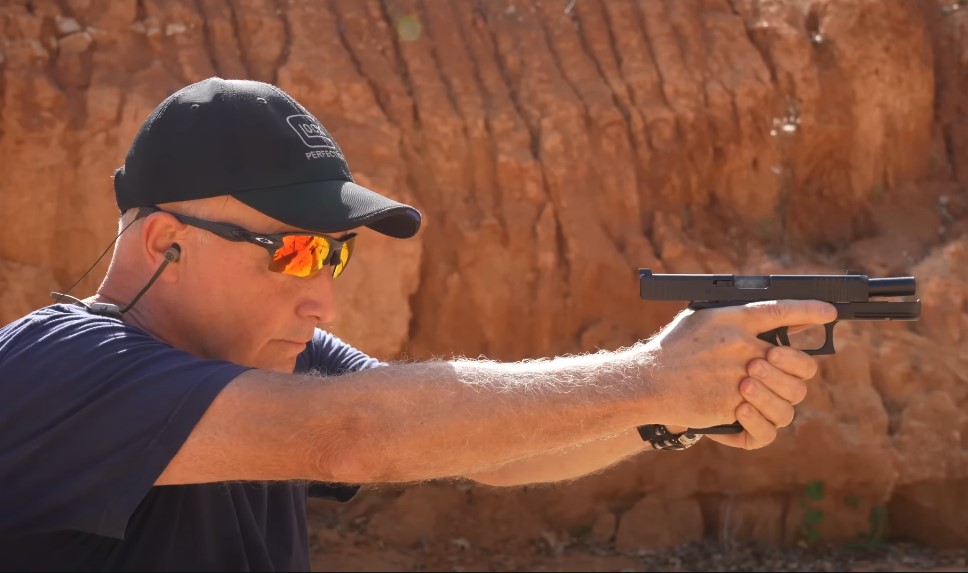Physical Address
304 North Cardinal St.
Dorchester Center, MA 02124
Physical Address
304 North Cardinal St.
Dorchester Center, MA 02124

The Glock 20 Gen 5 is admired for its power and reliability, but like any firearm, it’s not perfect.
From jamming issues to recoil management, understanding common Glock 20 Gen 5 problems can help gun enthusiasts keep their weapon performing smoothly.
Don’t worry most issues are simple to fix with the right approach. Let’s explore these problems and their easy solutions!
The Glock 20 Gen 5 is powerful, but it can face issues like jamming, misfeeding, or handling heavy recoil.
These problems might seem frustrating, but most are easy to fix with proper maintenance, quality ammo, and practice.
Stay proactive, and your Glock 20 will perform like a pro!

Cause
Magazine springs lose tension over time, especially with heavy 10mm rounds.
Dirty or damaged feed ramps can also prevent smooth cartridge movement.
Additionally, using low-quality ammunition or magazines that aren’t properly seated contributes to feeding problems.
Fixes
Replace worn magazine springs with OEM parts from Glock. Clean the feed ramp thoroughly with gun solvent and a soft brush.
Ensure magazines click firmly into place and use quality ammunition from reputable manufacturers. Consider replacing damaged magazines entirely.
Read Also: 8 Common Glock 19 Gen 5 Problems (With Easy Fixes)

Cause
A worn or damaged extractor can’t grip spent casings properly.
Weak ejector springs or accumulated carbon buildup around the ejection port also contribute to this problem.
Using underpowered ammunition may not provide sufficient energy for complete ejection.
Fixes
Inspect and replace the extractor if it shows wear or damage. Clean carbon buildup from the ejection port and surrounding areas.
Replace the ejector spring if it appears compressed or weak. Use full-power 10mm ammunition that meets factory specifications.
Cause
Firing pin springs weaken over thousands of rounds, reducing strike force.
Debris or oil in the firing pin channel can slow pin movement.
Using primers that require harder strikes than standard can also cause this issue.
Fixes
Replace the firing pin spring with a new OEM part.
Remove the firing pin and clean the channel thoroughly with appropriate solvents.
Ensure no oil remains in the firing pin area. Switch to standard primers if using hard primers.
Read Also: 7 Common Glock 44 Problems (With Easy Fixes)

Cause
Worn trigger springs lose their ability to return the trigger to the forward position. Dirt and debris in the trigger mechanism can also impede proper movement.
Over-lubrication sometimes causes sluggish trigger action.
Fixes
Disassemble the trigger group and inspect all springs for wear or damage. Clean all trigger components with degreasing solvent and reassemble dry.
Replace worn springs with genuine Glock parts. Apply minimal lubrication only to specified contact points.
Cause
Worn slide lock springs reduce the mechanism’s ability to function properly.
Shooters with large hands or improper grip may inadvertently press the slide lock during firing.
Damaged slide lock components can also cause erratic behavior.
Fixes
Replace the slide lock spring if it appears weak or damaged.
Adjust your grip to avoid contact with the slide lock during firing.
File down any burrs or rough edges on the slide lock itself. Consider professional fitting if problems persist.
Cause
Dirt and debris build up in the magazine well, creating friction against magazine surfaces.
Worn magazine catch springs may not provide sufficient force.
Damaged magazine release buttons can also impede proper function.
Fixes
Clean the magazine well thoroughly with appropriate solvents and brushes.
Polish rough spots in the magazine well with fine abrasive paper. Replace the magazine catch spring if it shows signs of weakness.
Ensure the magazine release button moves freely without binding.
Cause
Barrel wear from thousands of rounds can affect accuracy, especially with hot 10mm loads.
Loose barrel hood or damaged crown also impact precision.
Accumulated lead or copper fouling in the barrel reduces accuracy over time.
Fixes
Deep clean the barrel with appropriate solvents and brushes to remove all fouling. Inspect the barrel crown for damage and have it recut if necessary.
Check barrel hood tightness and have a gunsmith assess if replacement is needed. Use quality ammunition appropriate for your intended use.
Cause
High-pressure 10mm ammunition creates significant stress on the polymer frame over time.
Manufacturing defects or material flaws can accelerate crack development.
Extreme temperature changes can also contribute to frame stress.
Fixes
Stop using the pistol immediately if cracks are discovered.
Contact Glock customer service for warranty evaluation and potential replacement.
Never attempt to repair frame cracks yourself. Consider using lower-pressure ammunition to reduce frame stress in the future.
Cause
Normal wear from thousands of firing cycles weakens the recoil spring over time.
Hot 10mm ammunition accelerates spring fatigue.
Manufacturing defects can cause premature failure in some cases.
Fixes
Replace the recoil spring assembly every 5,000 rounds or as recommended by Glock.
Use only genuine OEM replacement parts for proper fit and function.
Consider upgrading to a dual recoil spring system if available for your model.
Cause
Heavy recoil from 10mm ammunition can loosen sight screws over time.
Impact damage from drops or rough handling can also affect sight alignment.
Manufacturing tolerances may allow some sight movement during normal use.
Fixes
Check sight screws regularly and tighten with appropriate tools and thread-locking compound. Replace damaged sights with quality aftermarket or OEM options.
Consider upgrading to adjustable sights for better precision. Have a qualified gunsmith install sights if you’re uncomfortable doing it yourself.
The Glock 20 Gen 5 features a 10mm chamber, enhanced grip ergonomics, an improved trigger system, and durable materials for reliable performance.
Yes, the 10mm caliber offers sufficient power for hunting medium-sized game, making it a popular choice among hunters.
The Glock 20 Gen 5 comes with a standard magazine capacity of 15 rounds.
Yes, the Glock 20 Gen 5 allows for sight customization, including the option to install adjustable or night sights.
The design and weight of the Glock 20 Gen 5 help mitigate recoil, making it manageable despite the powerful 10mm cartridge.
Understanding these common problems and their solutions helps you maintain your Glock 20 Gen 5’s legendary reliability.
Regular cleaning, using quality ammunition, and replacing worn components prevents most issues before they become serious problems.
Remember that prevention is always better than repair.
Following Glock’s maintenance schedule, using appropriate ammunition, and addressing small issues quickly keeps your pistol functioning at peak performance.
When in doubt, consult with a qualified gunsmith who has experience with Glock pistols.
The Glock 20 Gen 5 remains one of the most reliable 10mm pistols available when properly maintained.
By staying ahead of these common issues, you’ll enjoy years of dependable service from this powerful firearm.